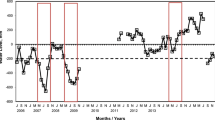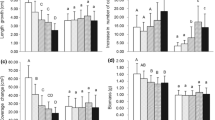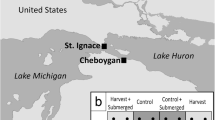Abstract
Where wetlands receive urban runoff, Typha spp. and other invasive plants often displace the native vegetation. We tested the ability of nutrients (N and P) to increase vegetative growth of T. × glauca (a hybrid of T. latifolia and T. angustifolia). In the greenhouse, 17 treatments revealed that T. × glauca required both N and P for growth, and total leaf length was most stimulated where a higher proportion of P was added (7N∶1P vs. 14N∶1P, with N constant and P changed), regardless of concentration (the High treatment was 4× the Low treatment). In Gardner Marsh (Madison, Wisconsin, USA), we set up 28 plots (1×6 m) that bisected the boundary between sedge meadow (graminoids) and T. × glauca, and we added a common lawn fertilizer (9N∶1P∶4K) at high (62.5 g/m2), medium (31.3 g/m2), low (15.6 g/m2), and control (0 g/m2) rates on five dates, with n=7 plots/treatment. After one growing season, fertilizer addition increased T. × glauca ramet density, height, and biomass, especially where the sedge meadow graminoids were initially dominant. Aboveground biomass of T. × glauca in the high nutrient addition treatment (1029±256.1 g/m2) was more than double that for control plots (431±80.52 g/m2) overall, with the greatest percent increase in sedge meadow subplots. In contrast, native graminoids (mostly Carex spp.) did not respond to treatment, either in biomass or percent cover. Typha × glauca allocated nutrients to both growth and storage, as indicated by higher N and P concentrations in leaves, shoot bases, and rhizomes in plots with high nutrient addition. Because fertilizing the marsh enhanced the shoot growth of T. × glauca but not native graminoids, and because the 7N∶1P treatment stimulated growth in the greenhouse, we suggest that wetland managers focus on reducing P inflows to urban wetlands. Fertilizer additions below those recommended by the manufacturer for new lawns (5× that of our highest treatment) should be more economical and have fewer impacts on receiving wetlands.
Similar content being viewed by others
Literature Cited
Aerts, R. and F. Berendse. 1988. The effect of increased nutrient availability on vegetation dynamics in wet healthlands. Vegetatio 76:63–69.
Aerts, L., M. A. Baker, P. J. Ewanchuk, and M. D. Bertness. 2000. Clonal integration and the expansion of Phragmites australis. Ecological Applications 10:1110–1118.
Auclair, A. N. D., A. Bouchard, and J. Pajaczkowski. 1976. Productivity relations in a Carex-dominated ecosystem. Oecologia (Berlin) 26:9–31.
Bastian, R. K. (ed.). 1993. Constructed wetlands for wastewater treatment and wildlife habitat. U.S. Environmental Protection Agency, Washington, DC, USA. EPA832-R-93-005.
Bedford, B. L., M. R. Walbridge, and A. Aldous. 1999. Patterns in nutrient availability and plant diversity of temperate North American wetlands. Ecology 80:2151–2169.
Bernard, J. M. and F. A. Bernard. 1973. Winter biomass in Typha glauca Godr. and Sparganium eurycarpum Engelm. Bulletin of the Torrey Botanical Club 100:125–131.
Bernard, J. M. and M. L. Fitz. 1979. Seasonal changes in above-ground primary production and nutrient contents in a central New York Typha glauca ecosystem. Bulletin of the Torrey Botanical Club 106:37–40.
Bernard, J. M. and B. A. Solsky. 1977. Nutrient cycling in a Carex lacustris wetland. Canadian Journal of Botany 55:630–638.
Bowden, W. B. 1987. The biogeochemistry of nitrogen in freshwater wetlands. Biogeochemistry 4:313–348.
Boyd, C. E. and L. W. Hess. 1970. Factors influencing shoot production and mineral nutrient levels in Typha latifolia. Ecology 51: 296–300.
Boyer, K. E. and J. B. Zedler. 1998. Effects of nitrogen additions the vertical structure of a constructed cordgrass marsh. Ecological Applications 8:692–705.
Boyer, M. L. H. and B. D. Wheeler. 1989. Vegetation patterns in spring-fed calcareous fens: calcite precipitation and constraints on fertility. Journal of Ecology 77:597–609.
Brown, S. C. and B. L. Bedford. 1997. Restoration of wetland vegetation with transplanted wetland soil: an experimental study. Wetlands 17:424–437.
Burke, M. J. W. and J. P. Grime. 1996. An experimental study of plant community invasibility. Ecology 77:776–790.
Chapin, F. S. III, E. Schulze, and H. A. Mooney. 1990. The ecology and economics of storage in plants. Annual Review of Ecology and Systematics 21:423–447.
Craft, C. B., J. Vymazal, and C. J. Richardson. 1995. Response of Everglades plant communities to nitrogen and phosphorus additions. Wetlands 15:258–271.
Davis, S. M. 1991. Growth, decomposition, and nutrient retention of Cladium jamaicense Crantz and Typha domingensis Pers. in the Florida Everglades. Aquatic Botany 40:203–224.
de Kroon, H. and J. van Groenendael (eds.) 1997. The Ecology and Evolution of Clonal Plants. Backhuys Publishers. Leiden, The Netherlands.
Ellstrand, N. C. and K. A. Schierenbeck. 2000. Hybridization as stimulus for the evolution of invasiveness in plants? Proceedings of the National Academy of Sciences 97:7043–7050.
Galatowitsch, S. M., N. O. Anderson, and P. D. Ascher. 1999. Invasiveness in wetland plants in temperate North America. Wetlands 19:733–755.
Garver, E. G., D. R. Dubbe, and D. C. Pratt. 1988. Seasonal patterns in accumulation and partitioning of biomass and macronutrients in Typha spp. Aquatic Botany 32:115–127.
Gerloff, G. C. and P. H. Krombholz. 1966. Tissue analysis as a measure of nutrient availability for the growth of angiosperm aquatic plants. Limnology and Oceanography 11:529–537.
Gorham, E. and M. G. Somers. 1973. Seasonal changes in the standing crop of two montane sedges. Canadian Journal of Botany 51:1097–1108.
Grime, J. P. 1979. Plant Strategies and Vegetation Processes. John Wiley and Sons, New York, NY, USA.
Hayati, A. A. and M. C. F. Proctor. 1991. Limiting nutrients in acid-mire vegetation: peat and plant analyses and experiments on plant responses to added nutrients. Journal of Ecology 79:75–95.
Hotchkiss, N. and H. L. Dozier. 1949. Taxonomy and distribution of North American cattails. The American Midland Naturalist 41: 237–254.
Huenneke, L. F., S. P. Hamburg, R. Koide, H. A. Mooney, and P. M. Vitousek. 1990. Effects of soil resources on plant invasion and community structure in California serpentine grassland. Ecology 71:478–491.
Hutchings, M. J. and D. K. Wijesinghe. 1997. Patchy habitats, division of labour and growth dividends in clonal plants. Trends in Ecology and Evolution 12:390–394.
Irwin, H. A. 1973. A natural history study of East Marsh of the University of Wisconsin Arboretum. M.S. Thesis, University of Wisconsin. Madison, WI, USA.
Jervis, R. A. 1969. Primary production in the freshwater marsh ecosystem of Troy Meadows, New Jersey. Bulletin of the Torrey Botanical Club 96:209–231.
Klimes, L., J. Klimesova, R. J. J. Hendriks and J. M. Van Groenendael. 1997. Clonal plants architecture: a comparative analysis of form and function. p. 1–29. In H. de Kron and J. Van Groenendael (eds.). The Ecology and Evolution of Clonal Plants. Backhuys Publishers, Leiden, The Netherlands.
Koerselman, W. and A. R. M. Meuleman. 1996. The vegetation N∶P ratio: a new tool to detect the nature of nutrient limitation. Journal of Applied Ecology 33:1441–1450.
Lee, G. F. 1971. Studies of nutrient sources for Lake Wingra: Lake Wingra Annual Report 1970–1971. Eastern Deciduous Forest Biome. University of Wisconsin, Madison, WI, USA. Memo Report #71-44.
Mack, R. N., D. Simberloff, W. M. Lonsdale, H. Evans, M. Clout, and F. Bazzaz. 2000. Biotic invasions: causes, epidemiology, global consequences and control. Ecological Application 10:689–710.
Marsh, L. C. 1951. Studies in the genus Typha. Ph.D. Dissertation. Syracuse University Syracuse, NY, USA.
McDonald, M. E. 1955. Cause and effects of a die-off of emergent vegetation. Journal of Wildlife Management 19:24–35.
Miao, S. L. and F. H. Sklar. 1998. Biomass and nutrient allocation of sawgrass and cattail along a nutrient gradient in the Florida Everglades. Wetlands Ecology and Management 5:245–263.
Montague, T. G. and T. J. Givnish. 1996. Distribution of black spruce vs. eastern larch along peatland gradients: relationship to relative stature, growth rate, and shade tolerance, and the significance of larch’s deciduous habit. Canadian Journal of Botany 74: 1514–1532.
Mooney, H. A., S. P. Hamburg, and J. A. Drake. 1986. The invasions of plants and animals into California. In H. A. Mooney and J. A. Drake (eds.) Ecology of Biological Invasions of North America and Hawaii. Springer-Verlag, New York, NY, USA.
Neill, C. 1990. Effects of nutrients and water levels on emergent macrophyte biomass in a prairie marsh. Canadian Journal of Botany 68:1007–1014.
Newman, S., J. Schuette, J. B. Grace, K. Rutchey, T. Fontaine, K. R. Reddy, and M. Peitrucha. 1998. Factors influencing cattail abundance in the northern Everglades. Aquatic Botany 60:265–280.
Prentki, R. T., D. S. Rogers, V. J. Watson, P. R. Weiler, and O. L. Loucks. 1977. Summary tables Lake Wingra basin data. Center for Biotic Systems, Institute for Environmental Studies. University of Wisconsin, Madison, WI, USA.
Richardson, C. J. and P. E. Marshall. 1986. Processes controlling movement, storage and export of phosphorus in a fen peatland. Ecological Monographs 56:279–302.
Runhaar, J., C. R. van Gool, and C. L. G. Groen. 1996. Impact of hydrological changes on nature conservation areas in The Netherlands. Biological Conservation 76:269–276.
SAS Institute. 1996. SAS system for mixed models. SAS Institute. Cary, NC, USA.
Smith, S. G. 1967. Experimental and natural hybrids in North American Typha (Typhaceae). The American Midland Naturalist 78: 257–287.
Tilman, D. and D. Wedin. 1991. Dynamics of nitrogen competition between successional grasses. Ecology 72:1038–1049.
Urban, N. H., S. M. Davis, and N. G. Aumen. 1993. Fluctuations in sawgrass and cattail densities in Everglades Water Conservation Area 2A under varying nutrient, hydrologic and fire regimes. Aquatic Botany 46:203–223.
Valiela, I. and J. M. Teal. 1979. The nitrogen budget of a salt marsh system. Nature 280:652–656.
Waters, I. and J. M. Shay. 1992. Effect of water depth on population parameters of a Typha glauca stand. Canadian Journal of Botany 70:349–351.
Weisner, S. E. B. 1993. Long-term competitive displacement of Typha latifolia by Typha angustifolia in a eutrophic lake. Oecologia 94:451–456.
Wilcox, D. A. 1986. The effects of deicing salts on vegetation in Pinhook Bog, Indiana. Canadian Journal of Botany 64:865–874.
Wilcox, D. A., S. I. Apfelbaum, and R. D. Hiebert. 1985. Cattail invasion of sedge meadows following hydrologic disturbance in the Cowles Bog wetland complex, Indiana Dunes National Lakeshore. Wetlands 4:115–128.
Author information
Authors and Affiliations
Rights and permissions
About this article
Cite this article
Woo, I., Zedler, J.B. Can nutrients alone shift a sedge meadow towards dominance by the invasive Typha × glauca . Wetlands 22, 509–521 (2002). https://doi.org/10.1672/0277-5212(2002)022[0509:CNASAS]2.0.CO;2
Received:
Revised:
Accepted:
Issue Date:
DOI: https://doi.org/10.1672/0277-5212(2002)022[0509:CNASAS]2.0.CO;2




